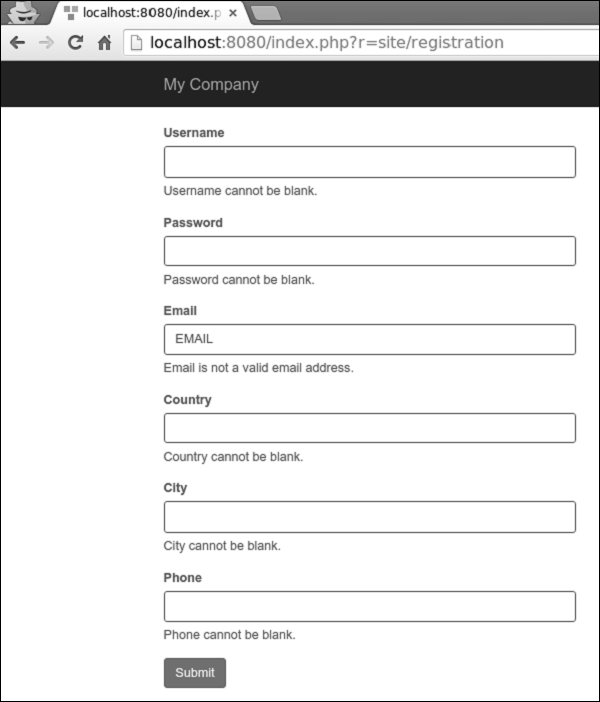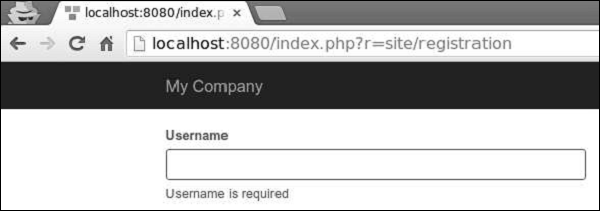
- Yii Tutorial
- Yii - Home
- Yii - Overview
- Yii - Installation
- Yii - Create Page
- Yii - Application Structure
- Yii - Entry Scripts
- Yii - Controllers
- Yii - Using Controllers
- Yii - Using Actions
- Yii - Models
- Yii - Widgets
- Yii - Modules
- Yii - Views
- Yii - Layouts
- Yii - Assets
- Yii - Asset Conversion
- Yii - Extensions
- Yii - Creating Extensions
- Yii - HTTP Requests
- Yii - Responses
- Yii - URL Formats
- Yii - URL Routing
- Yii - Rules of URL
- Yii - HTML Forms
- Yii - Validation
- Yii - Ad Hoc Validation
- Yii - AJAX Validation
- Yii - Sessions
- Yii - Using Flash Data
- Yii - Cookies
- Yii - Using Cookies
- Yii - Files Upload
- Yii - Formatting
- Yii - Pagination
- Yii - Sorting
- Yii - Properties
- Yii - Data Providers
- Yii - Data Widgets
- Yii - ListView Widget
- Yii - GridView Widget
- Yii - Events
- Yii - Creating Event
- Yii - Behaviors
- Yii - Creating a Behavior
- Yii - Configurations
- Yii - Dependency Injection
- Yii - Database Access
- Yii - Data Access Objects
- Yii - Query Builder
- Yii - Active Record
- Yii - Database Migration
- Yii - Theming
- Yii - RESTful APIs
- Yii - RESTful APIs in Action
- Yii - Fields
- Yii - Testing
- Yii - Caching
- Yii - Fragment Caching
- Yii - Aliases
- Yii - Logging
- Yii - Error Handling
- Yii - Authentication
- Yii - Authorization
- Yii - Localization
- Yii - Gii
- Gii – Creating a Model
- Gii – Generating Controller
- Gii – Generating Module
- Yii Useful Resources
- Yii - Quick Guide
- Yii - Useful Resources
- Yii - Discussion
Yii - Validation
You should never trust the data received from users. To validate a model with user inputs, you should call yii\base\Model::validate() method. It returns a Boolean value if the validation succeeds. If there are errors, you may get them from the yii\base\Model::$errors property.
Using Rules
To make the validate() function work, you should override the yii\base\Model::rules() method.
Step 1 − The rules() method returns an array in the following format.
[ // required, specifies which attributes should be validated ['attr1', 'attr2', ...], // required, specifies the type a rule. 'type_of_rule', // optional, defines in which scenario(s) this rule should be applied 'on' => ['scenario1', 'scenario2', ...], // optional, defines additional configurations 'property' => 'value', ... ]
For each rule, you should define at least which attributes the rule applies to and the type of rule applied.
The core validation rules are − boolean, captcha, compare, date, default, double, each, email, exist, file, filter, image, ip, in, integer, match, number, required, safe, string, trim, unique, url.
Step 2 − Create a new model in the models folder.
<?php
namespace app\models;
use Yii;
use yii\base\Model;
class RegistrationForm extends Model {
public $username;
public $password;
public $email;
public $country;
public $city;
public $phone;
public function rules() {
return [
// the username, password, email, country, city, and phone attributes are
//required
[['username' ,'password', 'email', 'country', 'city', 'phone'], 'required'],
// the email attribute should be a valid email address
['email', 'email'],
];
}
}
?>
We have declared the model for the registration form. The model has five properties − username, password, email, country, city, and phone. They are all required and the email property must be a valid email address.
Step 3 − Add the actionRegistration method to the SiteController where we create a new RegistrationForm model and pass it to a view.
public function actionRegistration() {
$model = new RegistrationForm();
return $this->render('registration', ['model' => $model]);
}
Step 4 − Add a view for our registration form. Inside the views/site folder, create a file called registration.php with the following code.
<?php
use yii\bootstrap\ActiveForm;
use yii\bootstrap\Html;
?>
<div class = "row">
<div class = "col-lg-5">
<?php $form = ActiveForm::begin(['id' => 'registration-form']); ?>
<?= $form->field($model, 'username') ?>
<?= $form->field($model, 'password')->passwordInput() ?>
<?= $form->field($model, 'email')->input('email') ?>
<?= $form->field($model, 'country') ?>
<?= $form->field($model, 'city') ?>
<?= $form->field($model, 'phone') ?>
<div class = "form-group">
<?= Html::submitButton('Submit', ['class' => 'btn btn-primary',
'name' => 'registration-button']) ?>
</div>
<?php ActiveForm::end(); ?>
</div>
</div>
We are using the ActiveForm widget for displaying our registration form.
Step 5 − If you go to the local host http://localhost:8080/index.php?r=site/registration and click the submit button, you will see validation rules in action.

Step 6 − To customize the error message for the username property, modify the rules() method of the RegistrationForm in the following way.
public function rules() {
return [
// the username, password, email, country, city, and phone attributes are required
[['password', 'email', 'country', 'city', 'phone'], 'required'],
['username', 'required', 'message' => 'Username is required'],
// the email attribute should be a valid email address
['email', 'email'],
];
}
Step 7 − Go to the local host http://localhost:8080/index.php?r=site/registration and click the submit button. You will notice that the error message of the username property has changed.

Step 8 − To customize the validation process, you may override these methods.
yii\base\Model::beforeValidate(): triggers a
yii\base\Model::EVENT_BEFORE_VALIDATE event.
yii\base\Model::afterValidate(): triggers a
yii\base\Model::EVENT_AFTER_VALIDATE event.
Step 9 − To trim the spaces around the country property and turn empty input of the city property into a null, you may the trim and default validators.
public function rules() {
return [
// the username, password, email, country, city, and phone attributes are required
[['password', 'email', 'country', 'city', 'phone'], 'required'],
['username', 'required', 'message' => 'Username is required'],
['country', 'trim'],
['city', 'default'],
// the email attribute should be a valid email address
['email', 'email'],
];
}
Step 10 − If an input is empty, you can set a default value for it.
public function rules() {
return [
['city', 'default', 'value' => 'Paris'],
];
}
If the city property is empty, then the default “Paris” value will be used.